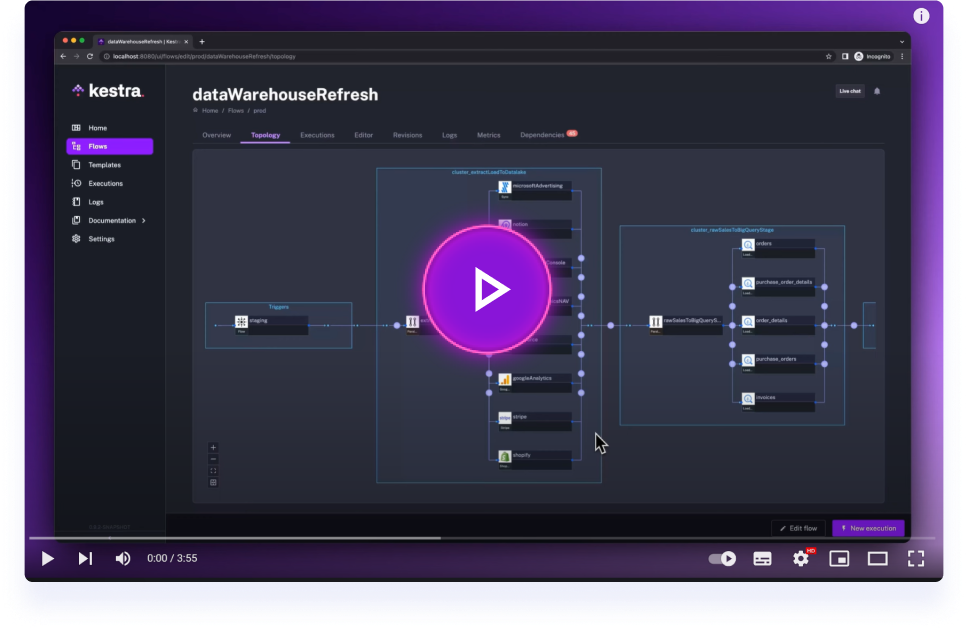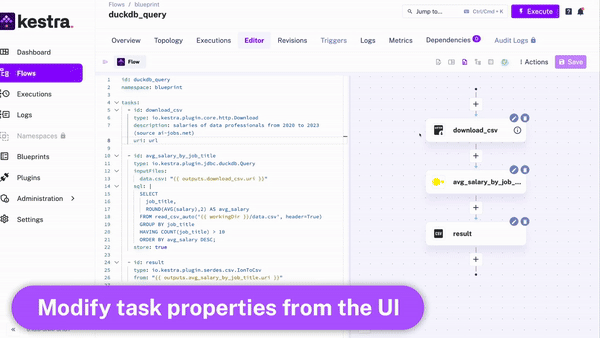Click on the image to get started with Kestra in 4 minutes.
Try Kestra using our live demo.
Kestra is a universal open-source orchestrator that makes both scheduled and event-driven workflows easy. By bringing Infrastructure as Code best practices to data, process, and microservice orchestration, you can build reliable workflows and manage them with confidence.
In just a few lines of code, you can create a flow directly from the UI. Thanks to the declarative YAML interface for defining orchestration logic, business stakeholders can participate in the workflow creation process.
Kestra offers a versatile set of language-agnostic developer tools while simultaneously providing an intuitive user interface tailored for business professionals. The YAML definition gets automatically adjusted any time you make changes to a workflow from the UI or via an API call. Therefore, the orchestration logic is always managed declaratively in code, even if some workflow components are modified in other ways (UI, CI/CD, Terraform, API calls).
Flowis the main component in Kestra. It's a container for your tasks and orchestration logic.Namespaceis used to provide logical isolation, e.g., to separate development and production environments. Namespaces are like folders on your file system — they organize flows into logical categories and can be nested to provide a hierarchical structure.Tasksare atomic actions in a flow. By default, all tasks in the list will be executed sequentially, with additional customization options, a.o. to run tasks in parallel or allow a failure of specific tasks when needed.Triggersdefine when a flow should run. In Kestra, flows are triggered based on events. Examples of such events include:- a regular time-based schedule
- an API call (webhook trigger)
- ad-hoc execution from the UI
- a flow trigger - flows can be triggered from other flows using a flow trigger or a subflow, enabling highly modular workflows.
- custom events, including a new file arrival (file detection event), a new message in a message bus, query completion, and more.
Inputsallow you to pass runtime-specific variables to a flow. They are strongly typed, and allow additional validation rules.
Most tasks in Kestra are available as plugins including plugins reacting to events from external systems in real-time (Kafka, Redis, Pulsar, AMQP, MQTT, NATS, AWS SQS, Google Pub/Sub, Azure Event Hubs) and script tasks supporting many programming languages (a.o., Python, R, Node.js, Shell, Go) and Docker containers.
To create your own plugins, check the plugin developer guide.
Kestra provides a variety of tasks to handle both simple and complex business logic, including:
- subflows
- retries
- timeout
- error handling
- conditional branching
- dynamic tasks
- sequential and parallel tasks
- skipping tasks or triggers when needed by setting the flag
disabledtotrue. - configuring dependencies between tasks, flows and triggers
- advanced scheduling and trigger conditions
- backfills
- blueprints
- documenting your flows, tasks and triggers by adding a markdown description to any component
- adding labels to add additional metadata to your flows such as the flow owner or team:
id: getting_started
namespace: company.team
description: Let's `write` some **markdown** - [first flow](https://t.ly/Vemr0) 🚀
labels:
owner: rick.astley
project: never-gonna-give-you-up
environment: dev
country: US
inputs:
- id: user
type: STRING
required: false
defaults: Rick Astley
description: This is an optional input. If not set at runtime, it will use the default value "Rick Astley".
variables:
first: 1
second: "{{ vars.first }} < 2"
tasks:
- id: hello
type: io.kestra.plugin.core.log.Log
description: this is a *task* documentation
message: |
The variables we used are {{ vars.first }} and {{ render(vars.second) }}.
The input is {{ inputs.user }} and the task was started at {{ taskrun.startDate }} from flow {{ flow.id }}.
- id: parallel
type: io.kestra.plugin.core.flow.Parallel
disabled: false
timeout: PT10M
concurrent: 2
tasks:
- id: task1
type: io.kestra.plugin.scripts.shell.Commands
commands:
- echo "running {{task.id}}"
- sleep 2
- id: task2
type: io.kestra.plugin.scripts.shell.Commands
commands:
- echo "running {{task.id}}"
- sleep 3
pluginDefaults:
- type: io.kestra.plugin.core.log.Log
values:
level: TRACE
retry:
type: constant # type: string
interval: PT15M # type: Duration
maxDuration: PT1H # type: Duration
maxAttempt: 5 # type: int
warningOnRetry: true # type: boolean, default is false
triggers:
- id: monthly
type: io.kestra.plugin.core.trigger.Schedule
cron: "0 9 1 * *" # every first day of the month at 9amYou can write workflows directly from the UI. When writing your workflows, the UI provides:
- autocompletion
- syntax validation
- embedded plugin documentation
- example flows provided as blueprints
- topology view (view of your dependencies in a Directed Acyclic Graph) that gets updated live as you modify and add new tasks.
We release new versions every first Tuesday of every second month. Give the repository a star to stay up to date with the latest releases and get notified about future updates.
Follow the steps below to start local development.
Make sure that Docker is installed and running on your system. The default installation requires the following:
Download the Docker Compose file:
curl -o docker-compose.yml https://raw.githubusercontent.com/kestra-io/kestra/develop/docker-compose.ymlAlternatively, you can use wget https://raw.githubusercontent.com/kestra-io/kestra/develop/docker-compose.yml.
Start Kestra:
docker compose up -dOpen http://localhost:8080 in your browser and create your first flow.
Here is a simple example logging hello world message to the terminal:
id: getting_started
namespace: dev
tasks:
- id: hello_world
type: io.kestra.plugin.core.log.Log
message: Hello World!For more information:
- Follow the getting started tutorial.
- Read the documentation to learn how to:
- Develop your flows
- Deploy Kestra
- Use the official Terraform provider to deploy your flows.
Kestra is built on top of a plugin ecosystem. You can browse through hundreds of pre-built plugins or build your own.
This list is growing quickly and we welcome contributions.
If you need help or have any questions, reach out using one of the following channels:
- Slack - join the community and get the latest updates.
- Twitter - to follow up with the latest updates.
We love contributions, big or small. Check out our contributor guide for details on how to contribute to Kestra.
See our Plugin Developer Guide for details on developing and publishing Kestra plugins.
Apache 2.0 © Kestra Technologies








